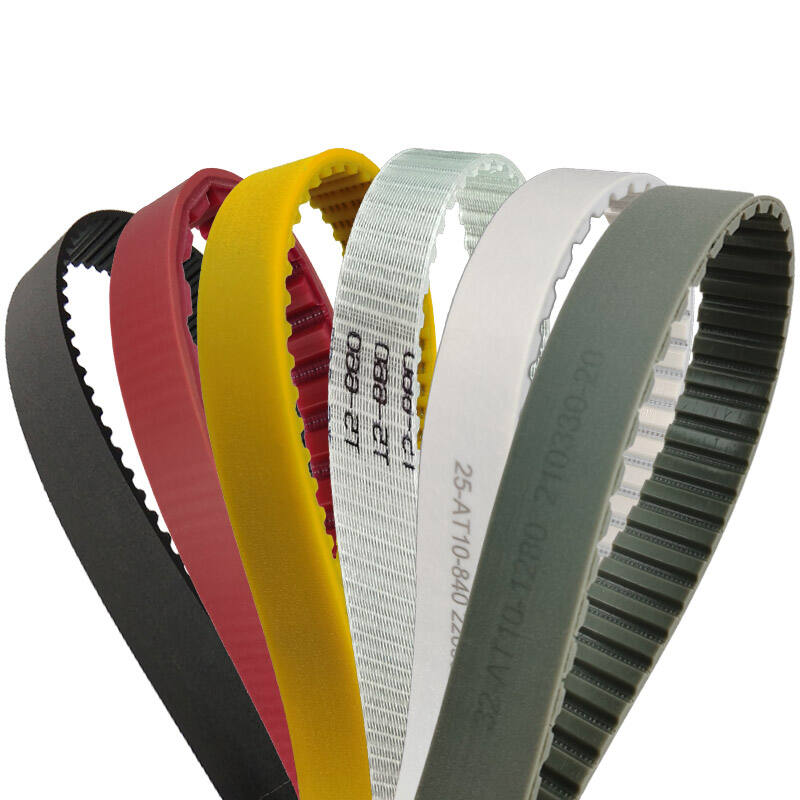Environmental Benefits of PU Timing Belts
Eco-friendly properties of polyurethane and contribution to sustainability
Polyurethane timing belts are made from a material that actually has a smaller footprint on the environment when compared to traditional petroleum based rubbers. When these belts are produced, they release around 40 percent less greenhouse gas emissions according to research published by EcoMaterial Insights back in 2023. Plus, manufacturers don't need to include dangerous chemicals such as chlorine in their production process. What's more, because this material is basically non toxic, it meets all the requirements set forth by the Environmental Protection Agency regarding worker safety. There aren't any nasty side effects created while making these products either. For companies looking to go green without sacrificing quality, PU timing belts represent a genuinely sustainable option worth considering.
Energy efficiency in industrial operations
Polyurethane timing belts have this slick design that cuts down on friction, which means they eat up about 15% less power than old school rubber belts according to research from Energy Efficiency Journal back in 2023. Conveyor systems running these belts actually need smaller motors to get the job done, saving around $7,200 every year for each production line. Think about it over a decade period and we're talking about preventing 18 metric tons of carbon dioxide from entering our atmosphere. That's not just good for the bottom line either, it makes factories run cleaner while still keeping their productivity levels high.
Recyclability and end-of-life management of PU belts
PU timing belts are 85% recyclable through pyrolysis, a process that converts used belts into reusable industrial compounds (Circular Materials Report 2023). Dedicated recycling programs in the EU and North America divert over 6,000 tons of belt waste from landfills annually, supporting circular economy goals with minimal ecological impact.
Comparison of environmental footprint: PU vs rubber and other materials
| Metric | PU Belts | Rubber Belts | Metal Chains |
|---|---|---|---|
| Carbon footprint (kg CO₂/t) | 320 | 540 | 1,100 |
| Recyclability rate | 85% | 45% | 92% |
| Energy use (kWh/unit) | 18 | 27 | 42 |
Source: 2024 Material Sustainability Report
PU belts offer a balanced advantage—outperforming rubber in carbon emissions and energy use, while approaching metal chains in recyclability, without sacrificing durability.
Durability and Low Maintenance in Demanding Industrial Environments
Long Service Life and Resistance to Wear Under Continuous Operation
PU timing belts last 2–3 times longer than rubber belts in continuous operation, maintaining <1% elongation after 8,000 hours under high torque. Their cross-linked polymer structure resists abrasive wear, reducing groove deformation by 78% compared to neoprene (Advanced Manufacturing Materials Study 2023), which extends equipment life and reduces replacement frequency.
Performance in Oil, Chemical, and Temperature-Extreme Conditions
In oil-rich environments, PU belts swell 83% less than rubber and retain 91% of their tensile strength after chemical exposure. They operate reliably from -40°C to 120°C, maintaining integrity in extreme conditions found in foundries and food processing plants—environments where conventional materials degrade prematurely (Industrial Polymer Performance Report 2022).
Reduced Downtime and Maintenance Costs
The contamination-resistant design of PU belts reduces unscheduled downtime by 32% annually in automated lines. Maintenance costs average $14 per operating hour—less than half the $27/hour for rubber systems—with replacement intervals extended from 6 to 18 months in typical conveyor applications (Logistics Efficiency Benchmark 2023).
Precision and Reliable Power Transmission
High Synchronization and Minimal Slippage in Motion Control
PU timing belts provide ±0.5mm positional accuracy due to precise tooth profiles and low-stretch material. They maintain exact speed ratios even at 5,000 RPM, minimizing slippage and energy loss. Their stability ensures synchronized motion in robotics and CNC systems—essential for applications requiring micron-level repeatability.
Consistent Performance in Automated and High-Precision Systems
Over 18,000 hours of continuous operation, PU belts show less than 0.2% efficiency decline, significantly outperforming rubber belts that degrade 3–4 times faster under similar loads. Their resistance to backlash prevents misalignment in multi-axis setups, a critical factor in semiconductor manufacturing where vibration errors can cost $740k/hour in defective wafers (Ponemon 2023).
Case Study: Efficiency Gains in Automated Assembly Lines Using PU Timing Belts
One major auto parts maker saw downtime drop by almost 40% when they swapped out those old nylon reinforced rubber belts for PU alternatives on their electric vehicle battery production line. This switch knocked 12 monthly maintenance stops right off the schedule and brought down energy consumption by nearly 20%. The company actually got back all their investment costs in just under eight months. According to industry experts looking at the situation, most of these gains come from PU's remarkable ability to transmit torque efficiently even when temps swing wildly between minus 40 degrees Celsius and a scorching 120 degrees Celsius. That kind of performance makes all the difference in manufacturing environments where temperature extremes are part of daily operations.
Key Applications Across Industries
Automation and Precision Manufacturing Systems
Polyurethane timing belts work really well on automated production lines that need synchronization down to the millimeter. The way these belts engage their teeth helps maintain precision when running CNC machines or operating robotic arms, which cuts down on those annoying positional errors. Take semiconductor manufacturing for example - companies often deal with tolerances as small as 0.005 mm. Here, PU belts help prevent that tiny bit of slippage that might otherwise damage delicate wafers during processing. A recent report from Motion Systems in 2024 showed something interesting too. Factories that switched to PU belts for their optical inspection systems saw about 17 percent fewer production stoppages compared to plants still relying on old fashioned chain drives.
Safe and Hygienic Use in Food Processing: Compliance With FDA and Non-Toxic Standards
PU timing belts that are food grade actually comply with FDA regulations (21 CFR §177.2600) when it comes to touching food indirectly. Plus they don't need those plasticizers which can sometimes seep into what's being processed. The design of these belts with their closed cell structure really helps stop bacteria from growing on them, so they work great in places like dairy plants and beverage lines where cleaning is done through CIP systems. One big name in the baking industry saw their belt replacement expenses drop around 40 percent once they made the switch to PU belts according to recent findings published last year in the Food Processing Equipment Hygiene Review.
Versatility in Conveyor and Material Handling Systems
Polyurethane timing belts can take on serious weight without stretching at all, typically handling between 2kg per meter right up to 5,000kg per meter. These belts work great in all sorts of places, from moving luggage around airports to heavy duty conveyor systems in mines. They stay grippy even when exposed to oils and greases, making them perfect for automotive manufacturing floors where lubricants are everywhere. Some versions come with special antistatic properties too, which helps prevent dangerous sparks when dealing with grains or other flammable materials. The modular design really makes a difference for warehouses dealing with e-commerce packages. Real world tests showed that warehouse operators could adjust their systems 22 percent quicker with these PU belts than they ever could with traditional PVC options.
FAQ
What are the main environmental benefits of PU timing belts?
PU timing belts offer several environmental benefits including reduced greenhouse gas emissions, non-toxic production processes, energy efficiency, and high recyclability.
How do PU timing belts improve energy efficiency in factories?
PU timing belts reduce friction and power consumption by about 15%, allowing factories to use smaller motors, leading to significant energy savings.
Are PU timing belts recyclable?
Yes, PU timing belts are 85% recyclable through pyrolysis, contributing to circular economy goals.
How do PU belts perform compared to rubber belts?
PU belts have a smaller carbon footprint, higher energy efficiency, and better recyclability compared to rubber belts.
What industries benefit from using PU timing belts?
Industries such as automation, food processing, and manufacturing benefit from PU timing belts due to their precision, hygiene standards, and versatility.

 EN
EN
 AR
AR
 HR
HR
 DA
DA
 NL
NL
 FR
FR
 DE
DE
 EL
EL
 HI
HI
 IT
IT
 JA
JA
 KO
KO
 NO
NO
 PL
PL
 PT
PT
 RO
RO
 RU
RU
 ES
ES
 TL
TL
 IW
IW
 ID
ID
 SR
SR
 SK
SK
 UK
UK
 VI
VI
 TH
TH
 TR
TR
 AF
AF
 MS
MS
 IS
IS
 HY
HY
 AZ
AZ
 KA
KA
 BN
BN
 LA
LA
 MR
MR
 MY
MY
 KK
KK
 UZ
UZ
 KY
KY
